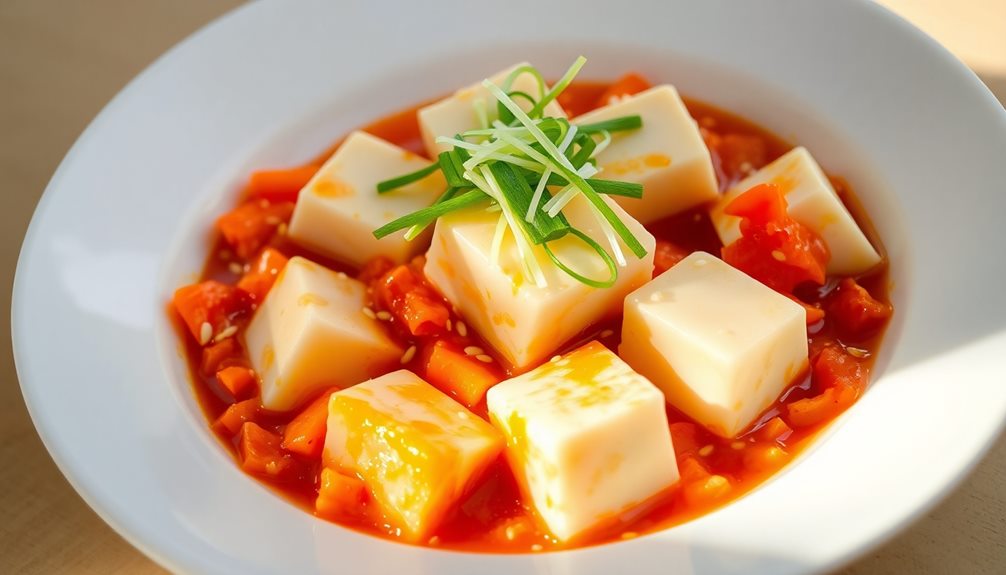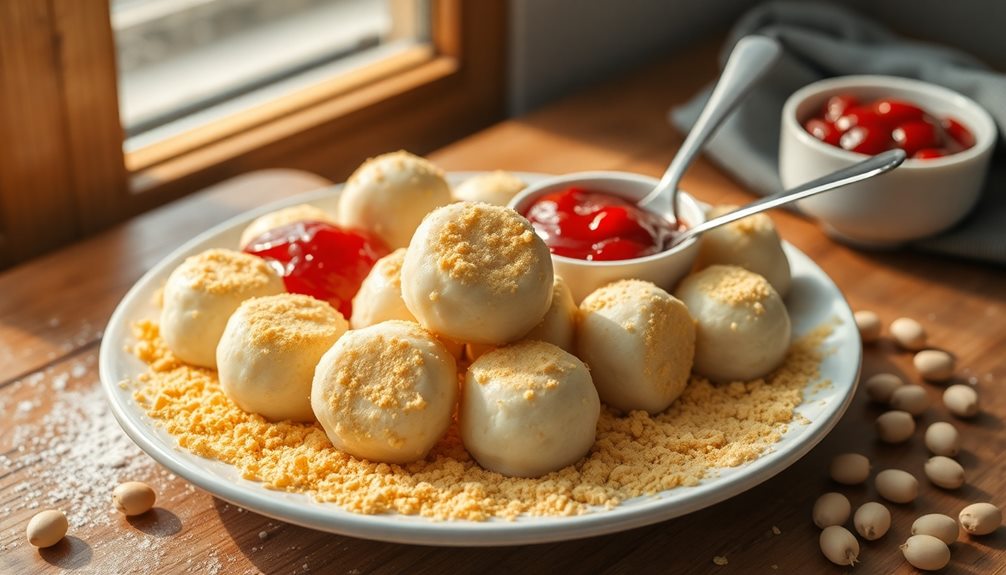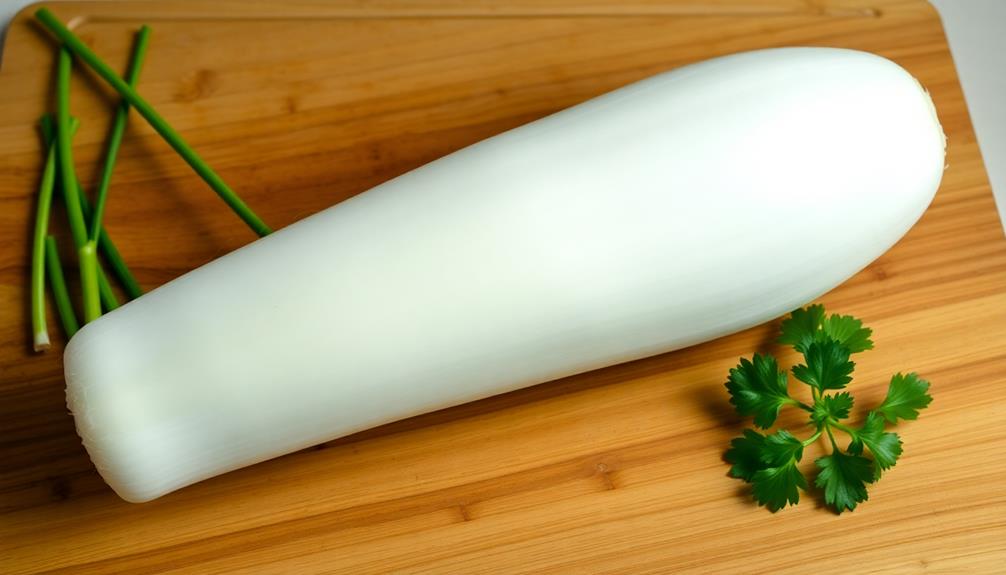Dive into the captivating world of sikhye, Korea's beloved rice punch! This centuries-old delight has a rich history, evolving from a royal court treat to a cherished beverage enjoyed year-round. To make this refreshing elixir, you'll soak glutinous rice overnight before blending it into a silky smooth mixture. After straining and boiling the rice, simply chill it and savor the subtly sweet, nutty flavor. Sikhye is perfect for any occasion – from casual gatherings to festive celebrations. Its cultural significance runs deep, reflecting Korea's culinary heritage. One sip, and you'll understand why this treasured drink has stood the test of time.
Key Takeaways
- Sikhye, a traditional Korean rice punch, has a rich history dating back centuries and is often enjoyed during festive occasions like Lunar New Year and Chuseok.
- The fermentation process and addition of ingredients like pine nuts or dates have led to the development of regional variations, each with unique flavors.
- The preparation of sikhye involves soaking the rice overnight, blending it with water, straining the mixture, and then boiling it to achieve a porridge-like consistency.
- Serving chilled sikhye provides a refreshing and subtly nutty experience, making it a versatile beverage suitable for both casual and formal settings.
- Sikhye is a cultural treasure that reflects Korea's culinary heritage and fosters connections among people, as it is often shared and enjoyed together.
History

Korean rice punch, known as sikhye, has a rich history dating back centuries. This beloved beverage has been enjoyed by Koreans for generations, passed down from one family to the next.
Originating as a royal court drink, sikhye was initially reserved for special occasions and served to honored guests.
Over time, the recipe evolved, with each region developing its own unique twist. Some added pine nuts or dates for extra flavor, while others preferred a sweeter version. The process of making sikhye also became more refined, with skilled cooks carefully controlling the fermentation to achieve the perfect balance of sweetness and starchiness.
Today, sikhye remains a beloved part of Korean culture, enjoyed throughout the year but especially during the Lunar New Year and Chuseok (Korean Thanksgiving) celebrations.
Whether served chilled or at room temperature, this delightful rice punch continues to bring joy and comfort to those who savor its unique taste.
Cooking Steps
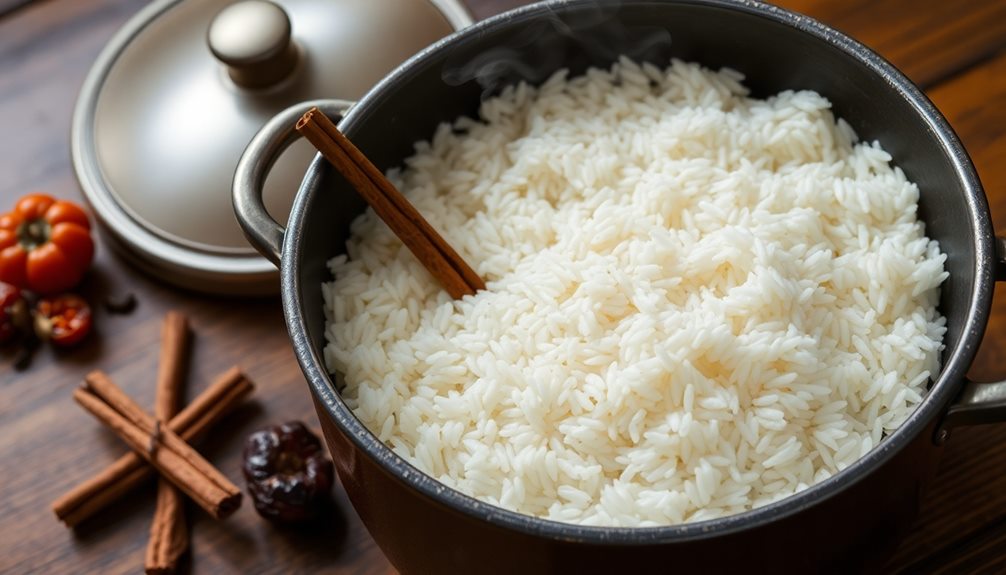
To begin, gather all the necessary ingredients and equipment. You'll need a large pot, a wooden spoon, and a cheesecloth or fine-mesh strainer. Measure out the glutinous rice, water, and sugar. Don't forget the cinnamon sticks and dried jujube dates!
Next, rinse the glutinous rice until the water runs clear. This will help remove any impurities. Then, add the rice and water to the pot and bring it to a boil over high heat.
Once it's boiling, reduce the heat to low, cover the pot, and let it simmer for about an hour, stirring occasionally, until the rice is very soft and broken down.
Carefully remove the pot from the heat and stir in the sugar and cinnamon sticks. Let the punch cool for a bit before straining it through the cheesecloth or strainer to remove any remaining rice grains.
Serve the Korean rice punch warm or chilled, garnished with the softened jujube dates. Enjoy this sweet and comforting treat!
Step 1. Soak Rice Overnight Before Cooking
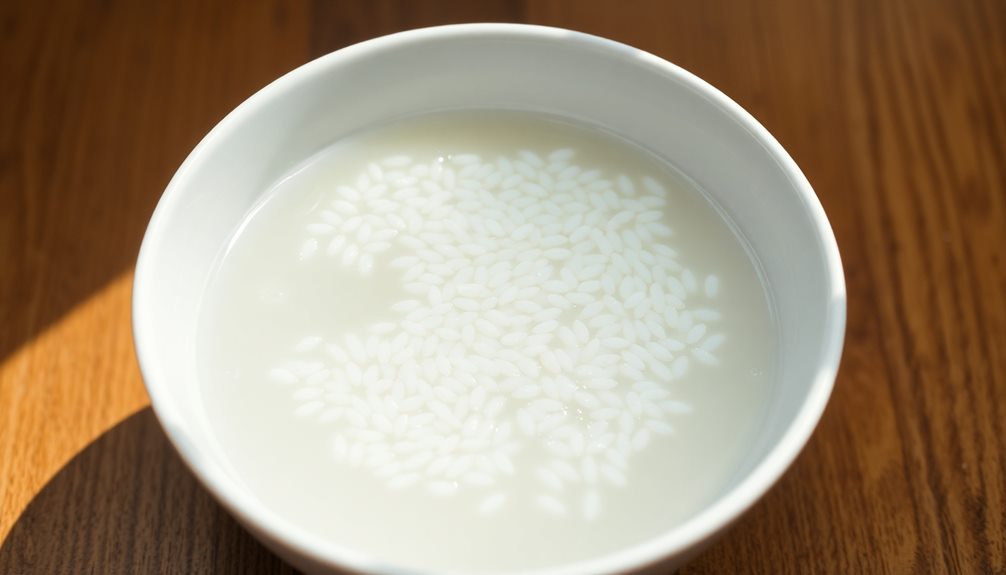
Soaking the rice overnight is a crucial step in preparing the perfect Korean rice punch. It's like giving your rice a little spa treatment before it gets cooked!
By letting the rice soak, you're helping it absorb more water and become extra soft and fluffy. When you soak the rice, make sure to use cold water and let it sit for at least 8 hours, or even overnight. This allows the rice grains to fully expand and become more tender.
Don't skip this step – it makes a big difference in the final texture of your rice punch. Once the soaking is done, you'll need to drain the rice and give it a quick rinse. This helps remove any excess starch, leaving you with a clean, pure rice flavor.
Now you're ready to move on to the next step of the cooking process. Get excited, because your homemade Korean rice punch is about to reach a whole new level of deliciousness!
Step 2. Blend Rice and Water Thoroughly
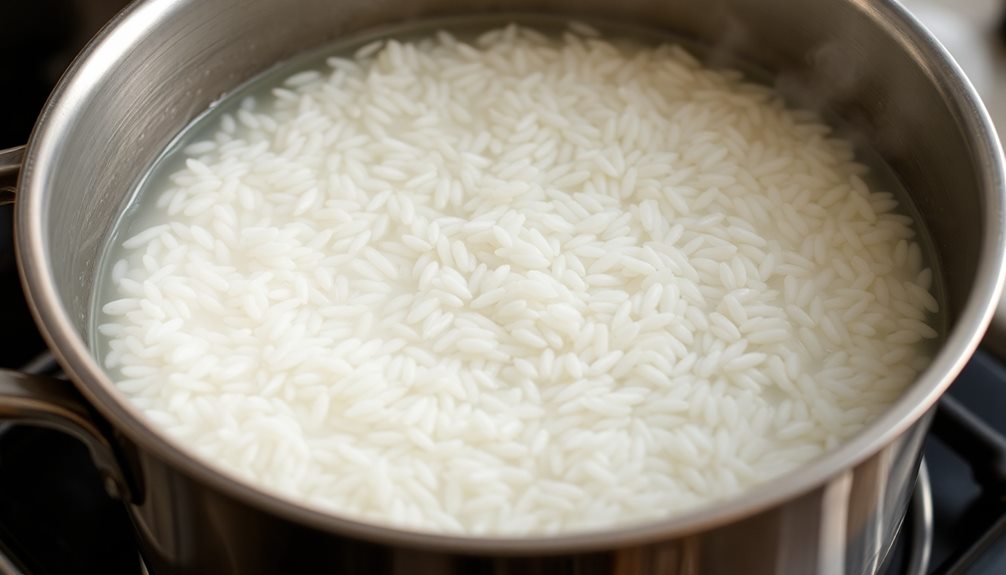
Now that the rice has finished soaking, it's time to blend it with water. Grab your trusty blender and add the soaked rice.
Pour in the water, making sure to use the right ratio – you'll want about 4 cups of water for every 1 cup of rice.
Blend the mixture on high speed for a couple of minutes until it's nice and smooth. You'll know it's ready when the rice is completely broken down and the texture is silky.
Don't be afraid to blend a little longer if you still see any grains. A well-blended rice and water mixture is key for getting that perfect, velvety Korean rice punch.
Once it's all blended up, go ahead and give it a taste. Adjust the water amount if needed to get the consistency you like.
Now you're ready to move on to the next step – cooking the rice punch on the stove. Get ready for a delicious, traditional Korean treat!
Step 3. Strain the Rice Mixture
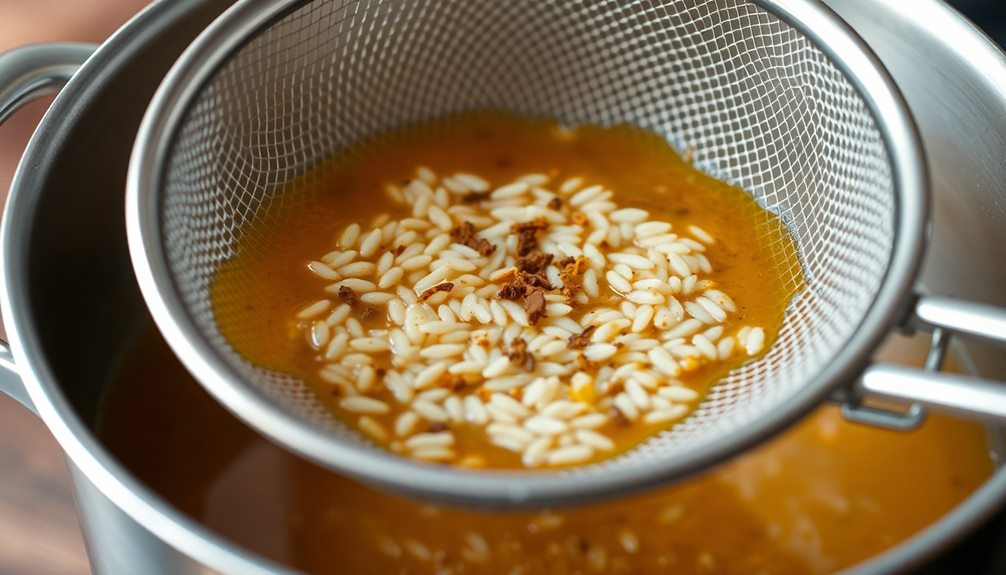
With your rice and water blended to perfection, it's time to strain the mixture.
Grab a fine-mesh strainer and carefully pour the contents over it, letting the liquid drain through while the rice solids remain.
Don't worry if there are a few stray grains – just give the strainer a gentle shake to remove as much liquid as possible.
Now, take the strained rice and transfer it to a clean pot or bowl.
This is where the magic happens! You'll notice the rice has a nice, thick, and creamy consistency.
This is exactly what you want for your delicious Korean rice punch.
Discard the strained liquid, as you won't be needing it for this recipe.
With the rice ready, you can now move on to the next step: adding the remaining ingredients to create the perfect balance of flavors.
Get ready to embark on a flavorful journey as you continue crafting your authentic Korean rice punch.
Step 4. Boil the Strained Rice Mixture
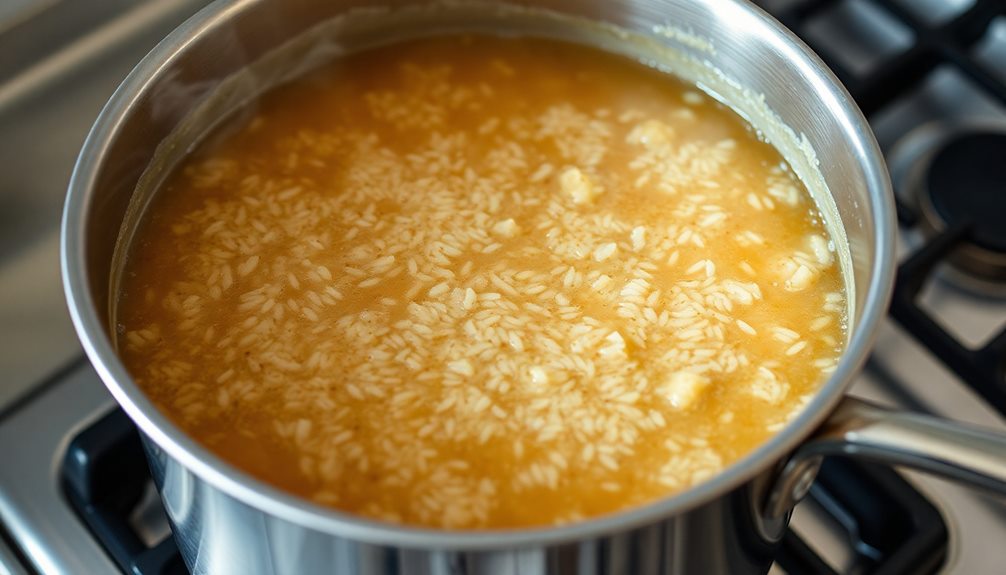
Once you've strained the rice mixture, transfer the creamy rice solids to a medium-sized pot.
Now, it's time to bring this mixture to a boil! Turn the heat to high and keep a close eye on the pot. You'll want to stir the rice regularly to prevent any sticking or burning.
As the mixture starts to bubble, reduce the heat to medium-low. This gentle simmer will help the rice break down even further, creating a delightfully smooth and creamy texture.
Let the rice mixture cook like this for about 15-20 minutes, stirring occasionally, until it reaches your desired consistency. You'll know it's ready when the rice has a porridge-like thickness.
Once it's done, remove the pot from the heat and get ready to assemble your Korean rice punch! With just a few more steps, you'll have a traditional and comforting beverage that's perfect for any occasion.
Step 5. Refrigerate and Serve Chilled

After cooking the rice mixture, transfer it to a large bowl or container.
You'll want to cover it and pop it in the fridge to chill for at least 2 hours. This allows the flavors to meld and the punch to get nice and cold.
Once it's properly chilled, you're ready to serve!
Grab some glasses and ladle the punch into them.
Give it a good stir before pouring to make sure all the yummy bits are evenly distributed.
You can garnish each glass with a lemon slice or a sprinkle of toasted sesame seeds if you're feeling fancy.
Mmm, doesn't that look refreshing?
The cool, slightly sweet rice punch is the perfect thirst-quencher on a warm day.
Sip it slowly and savor the unique, subtly nutty flavor.
Your guests will be so impressed by this traditional Korean treat.
Enjoy!
Final Thoughts

Delving into the final thoughts on Korean rice punch, you'll find that this traditional beverage is more than just a delightful drink. It's a cultural treasure that has been passed down through generations, reflecting the rich heritage and culinary artistry of Korea.
Shikeh, with its unique blend of sweet and savory flavors, offers a refreshing and satisfying experience that can be enjoyed year-round.
Beyond its taste, this rice punch holds a deeper significance. It's a drink that brings people together, fostering connections and creating lasting memories.
Whether you're sharing a glass with family, friends, or new acquaintances, Shikeh has a way of breaking down barriers and promoting a sense of community. Its versatility also makes it an ideal beverage for any occasion, from casual gatherings to formal celebrations.
As you delve into the world of Korean rice punch, you'll discover a world of tradition, flavor, and cultural richness waiting to be explored.
Embrace the warmth and joy that Shikeh brings, and let it become a cherished part of your culinary journey.
Frequently Asked Questions
What Is the Alcohol Content in Shikeh?
The alcohol content in Shikeh is typically low, usually around 5-6% ABV. While it's not a heavily alcoholic beverage, it still provides a subtle, refreshing kick that can complement any occasion. Enjoy responsibly and savor the unique flavors of this traditional Korean rice punch.
Can Shikeh Be Stored for a Long Time?
Yes, you can store shikeh for a long time. The fermentation process allows it to have a longer shelf life, so you can enjoy the drink even weeks after preparing it.
Is Shikeh Suitable for People With Dietary Restrictions?
As for your question, shikeh can be suitable for people with dietary restrictions, depending on the specific ingredients used and any modifications made. You'll want to check the recipe details to ensure it aligns with your dietary needs.
What Is the Traditional Way of Serving Shikeh?
Traditionally, you'd serve shikeh chilled, often in small cups or bowls. It's meant to be sipped and savored, allowing the flavors to unfold. Some may even garnish it with fresh fruit or edible flowers for a visually appealing presentation.
Are There Any Health Benefits Associated With Shikeh?
Are there health benefits to the rice punch you're curious about? Well, the fermentation process can provide probiotics, and the rice itself offers complex carbs and minerals. Enjoying it in moderation as part of a balanced diet may provide some nutritional advantages.


